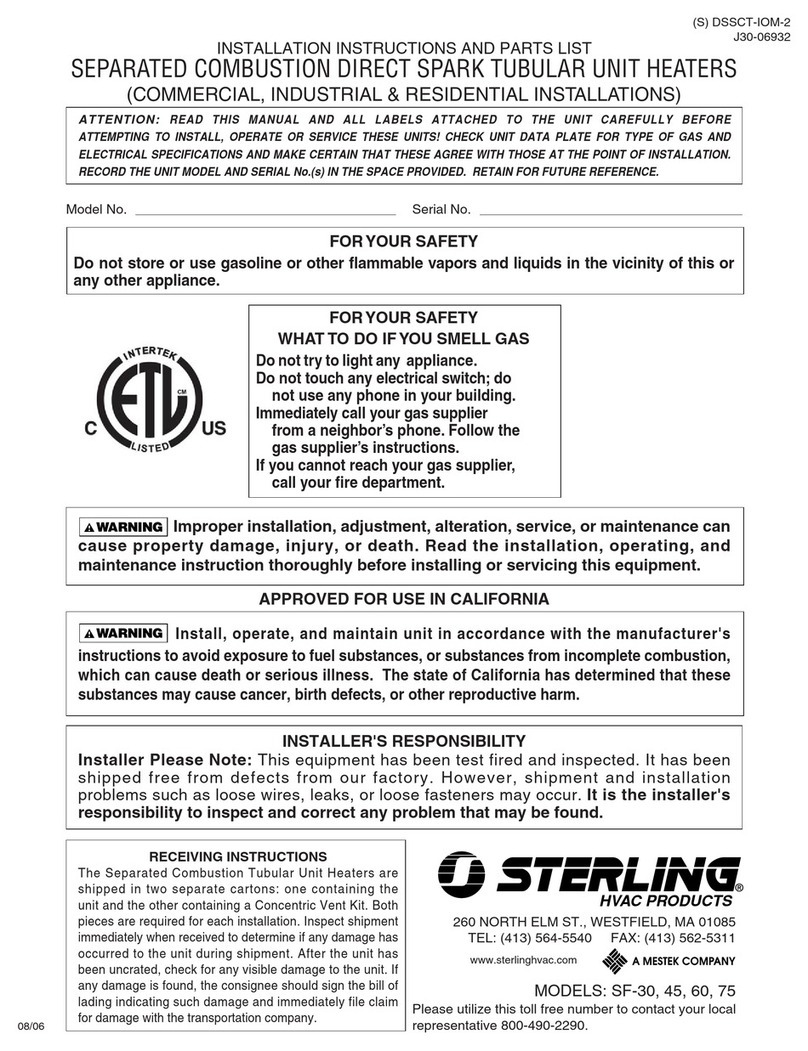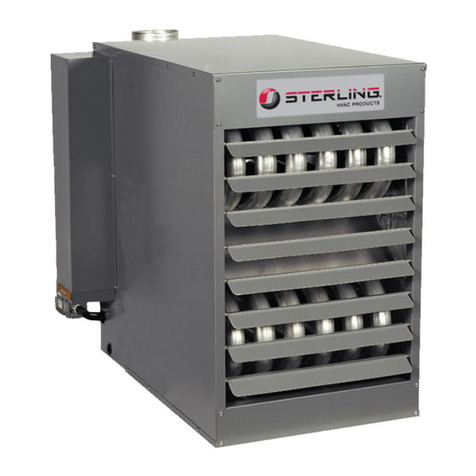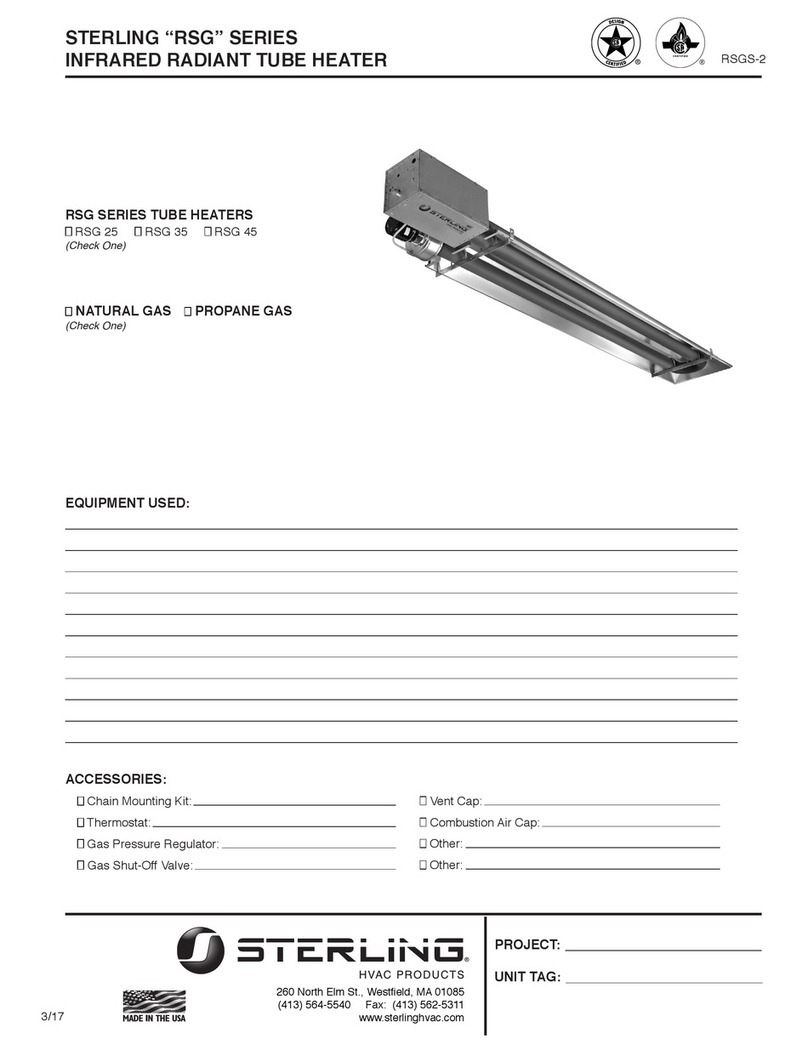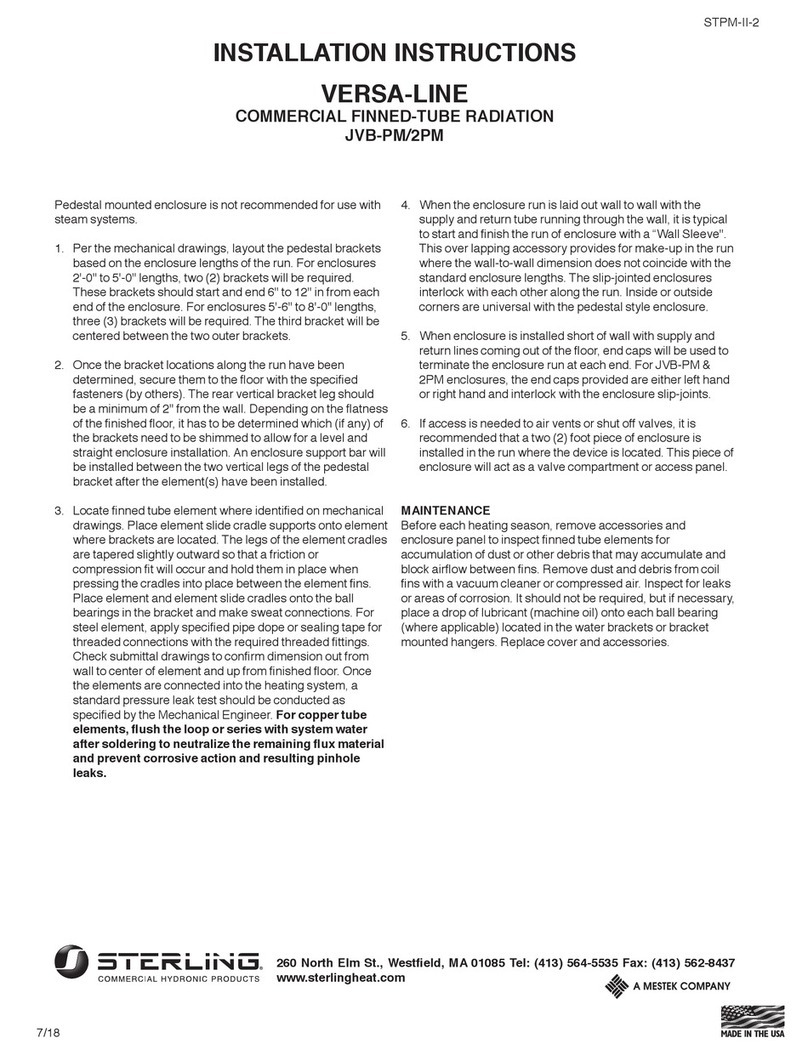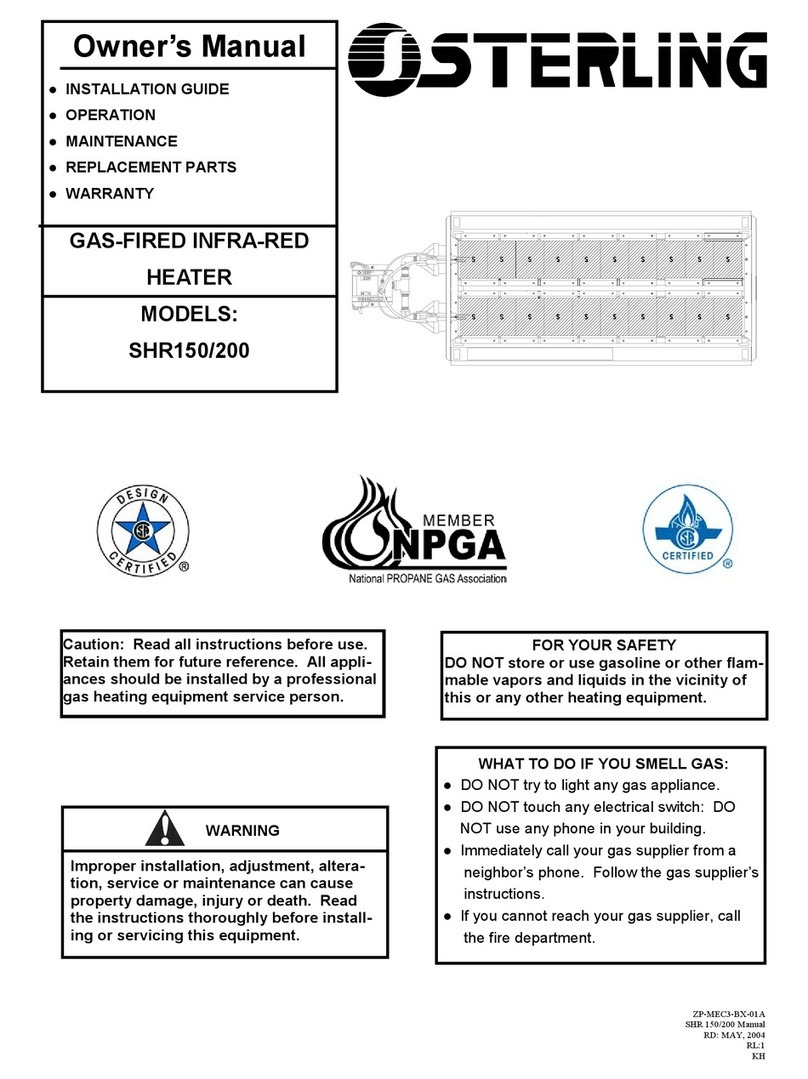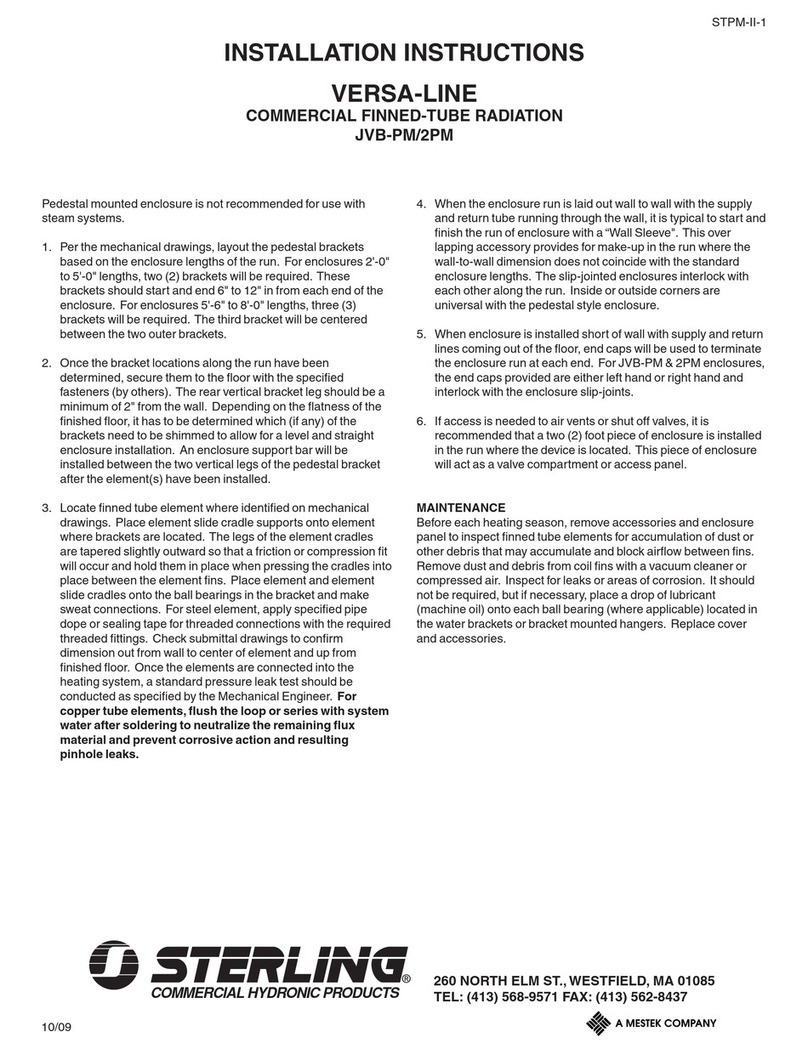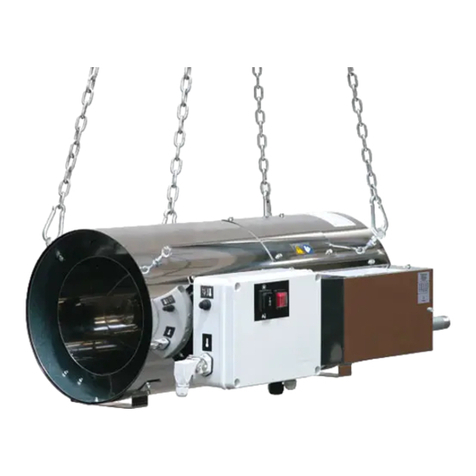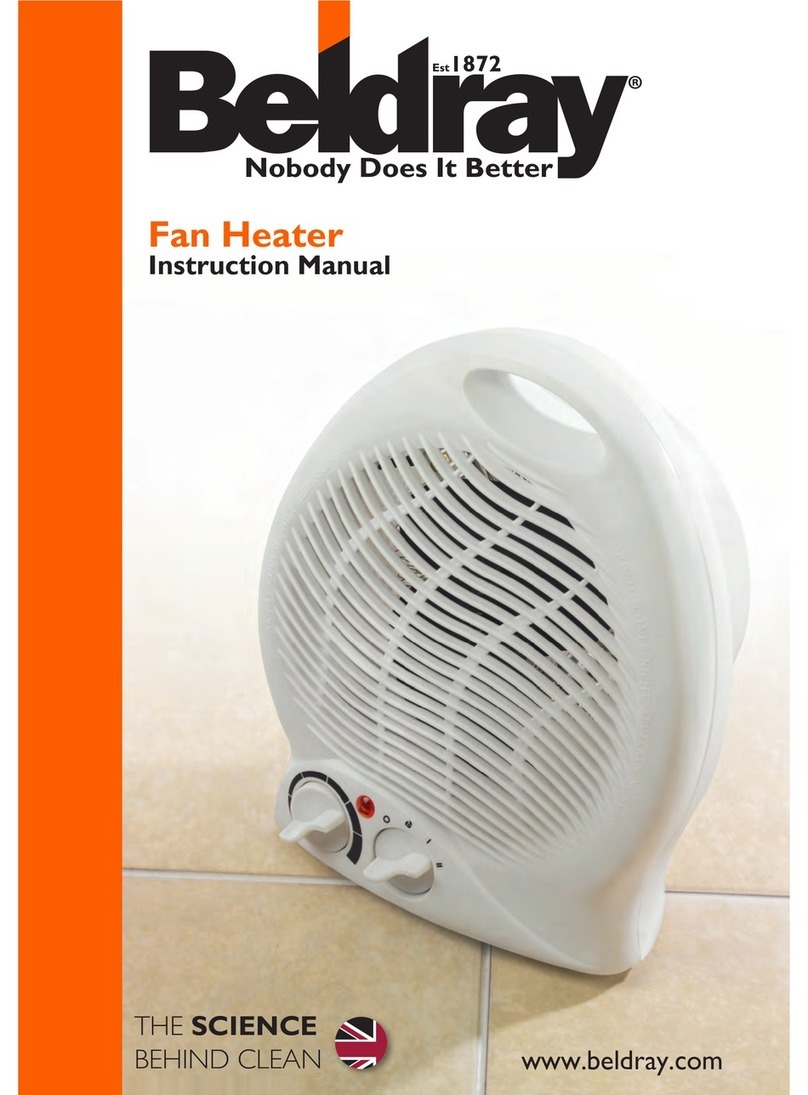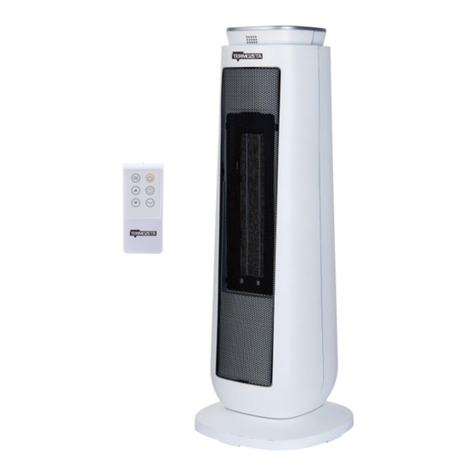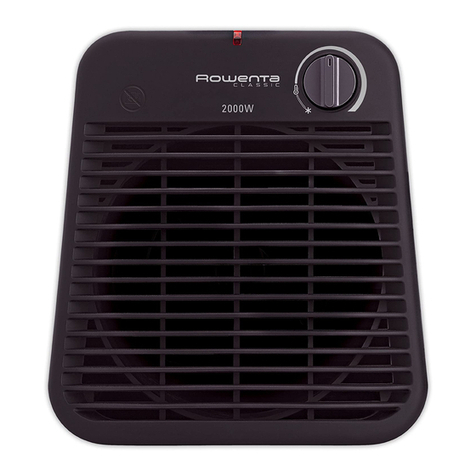Sterling QVSF 100 Datasheet

(S) PSCII-5
J30-05369
INSTALLATION INSTRUCTIONS & PARTS LIST
SEPARATED COMBUSTION
GAS FIRED PROPELLER UNIT HEATERS
www.sterlinghvac.com
FOR YOUR SAFETY
The use and storage of gasoline or other flammable vapors and liquids in open containers in
the vicinity of this appliance is hazardous.
FOR YOUR SAFETY
If you smell gas:
1. Open windows.
2. Don’t touch electrical switches.
3. Extinguish any open flame.
4. Immediately call your gas supplier.
Model No. Serial No.
ATTENTION: READ THIS MANUAL AND ALL LABELS ATTACHED TO THE UNIT CAREFULLY BEFORE
ATTEMPTING TO INSTALL, OPERATE OR SERVICE THESE UNITS! CHECK UNIT DATA PLATE FOR TYPE OF
GAS AND ELECTRICAL SPECIFICATIONS AND MAKE CERTAIN THAT THESE AGREE WITH THOSE AT POINT OF
INSTALLATION. RECORD THE UNIT MODEL AND SERIAL No.(s) IN THE SPACE PROVIDED. RETAIN FOR FUTURE
REFERENCE.
APPROVED FOR USE IN CALIFORNIA
INSTALLER'S RESPONSIBILITY
Installer Please Note: This equipment has been test fired and inspected. It has been
shipped free from defects from our factory. However, during shipment and installation,
problems such as loose wires, leaks or loose fasteners may occur. It is the installer's
responsibility to inspect and correct any problems that may be found.
RECEIVING INSTRUCTIONS
Inspect shipment immediately when
received to determine if any damage
has occurred to the unit during
shipment. After the unit has been
uncrated, check for any visible damage
to the unit. If any damage is found,
the consignee should sign the bill
of lading indicating such damage
and immediately file claim for
damage with the transportation
company.
MODELS: QVSF (100, 125, 150, 175, 200,
225, 250, 300, 350, 400)
260 NORTH ELM ST., WESTFIELD, MA 01085
TEL: (413) 564-5540 FAX: (413) 562-5311
HVAC PRODUCTS
Install, operate and maintain unit in accordance with manufacturer's
instructions to avoid exposure to fuel substances or substances from incomplete
combustion which can cause death or serious illness. The state of California
has determined that these substances may cause cancer, birth defects, or other
reproductive harm.
Improper installation, adjustment, alteration, service or maintenance
can cause property damage, injury or death. Read the installation, operating and
maintenance instructions thoroughly before installing or servicing this equipment.
1/08
Please utilize this toll free number to contact your local
representative 800-490-2290.

TABLE OF CONTENTS
2
SPECIFICATIONS
Basic Description.................................................... 2
Performance & Specification Data.......................... 4
GENERAL SAFETY INFORMATION
Installation Codes (throughout manual)..............2, 3
Special Precautions............................................ 2, 3
INSTALLATION
Locating Units..................................................... 5, 6
Proper Clearances..............................................5, 6
Suspension of Units............................................5, 6
Gas Supply Piping .............................................. 7, 8
Pipe Installation ...................................................... 8
ELECTRICAL CONNECTIONS........... 9, 10, 11, 12, 13
The following terms are used throughout this manual, in addition to CSA International requirements, to bring attention
to the presence of potential hazards or to important information concerning the product:
Figure 1 - Power Vented Separated Combustion Propeller Unit Heaters
See Identification of Parts Section
for unit components.
Front
View
Rear
View
Indicates an imminently hazardous
situation which, if not avoided, will result in death,
serious injury or substantial property damage.
Indicates an imminently hazardous
situation which, if not avoided, could result in
death, serious injury or substantial property
damage.
Indicates an imminently hazardous
situation which, if not avoided, may result in
minor injury or property damage.
NOTICE: Used to notify of special instructions on
installation, operation or maintenance which are
important to equipment but not related to personal
injury hazards.
INSTALLATION - VENTING
Combustion Air Venting & Piping.......................... 14
Exhaust Venting........................................14, 15, 16
OPERATION ................................................. 17, 18, 19
Adjustments.................................................... 17, 19
MAINTENANCE
Servicing & Cleaning ............................................ 20
IDENTIFICATION OF PARTS....................4, 18, 21, 26
TROUBLESHOOTING GUIDE................ 22, 23, 24, 25
Replacement Parts ............................................... 26
WARRANTY .............................................................. 27
INSPECTION SHEET................................................ 28
DESCRIPTION
by CSA International as providing a minimum of 80%
thermal efficiency, and approved for use in California.
Do not alter these units in any way. If you have
any questions after reading this manual, contact the
manufacturer.
The Power Vented gas unit heater is a factory assembled,
power vented, low static pressure type propeller fan
heater designed to be suspended within the space
to be heated.THESE HEATERS ARE NOT TO BE
CONNECTED TO DUCTWORK. The designs are certified
NOTICE: It is the equipment owner’s responsibility to provide any scaffolding or other apparatus required
to perform emergency service or annual/periodic maintenance to this equipment.

3
GENERAL SAFETY INFORMATION
Do not attempt to convert the
heater for use with a fuel other than the one
intended. Such conversion is dangerous, as it
will create the risks listed previously.
Make certain that the power source conforms to the
electrical requirements of the heater.
Do not depend upon a thermostat
or other switch as sole means of disconnecting
power when installing or servicing heater. Always
disconnect power at main circuit breaker as
described above. Failure to do so could result in
fatal electric shock.
Special attention must be given to any grounding
information pertaining to this heater. To prevent the
risk of electrocution, the heater must be securely and
adequately grounded. This should be accomplished by
connecting a grounded conductor between the service
panel and the heater. To ensure a proper ground,
the grounding means must be tested by a qualified
electrician.
Do not insert fingers or foreign objects into the heater
or its air moving device. Do not block or tamper with the
heater in any manner while in operation or just after it
has been turned off, as some parts may be hot enough
to cause injury.
This heater is intended for general heating applications
ONLY. It must NOT be used in potentially dangerous
locations such as flammable, explosive, chemical-laden
or wet atmospheres.
Do not attach ductwork to this product or use it as a
makeup air heater. Such usage voids the warranty and
will create unsafe operation.
In cases in which property damage may result from
malfunction of the heater, a backup system or a
temperature sensitive alarm should be used.
The open end of piping systems
being purged shall not discharge into areas
where there are sources of ignition or into
confined spaces UNLESS precautions are taken
as follows: (1) By ventilation of the space, (2)
control of purging rate, (3) elimination of all
hazardous conditions. All precautions must be
taken to perform this operation in a safe manner!
Unless otherwise specified, the following conversions
may be used for calculating SI unit measurements:
1 foot = 0.305 m
1 inch = 25.4 mm
1 psig = 6.894 kPa
1 pound = 0.453 kg
1 gallon = 3.785 L
Failure to comply with the General
Safety Information may result in extensive property
damage, severe personal injury or death.
This product must be installed by
a licensed plumber or gas fitter when installed
within the Commonwealth of Massachusetts.
Installation must be made in accordance with local
codes, or in absence of local codes with the latest
edition of ANSI Standard Z223.1 (N.F.P.A. No.54)
National Fuel Gas Code. All of the ANSI and NFPA
Standards referred to in these installation instructions
are those that were applicable at the time the design of
this appliance was certified. The ANSI Standards are
available from the American National Standards Institute,
Inc.,11 West 42nd Street, New York, NY, 10036 or www.
ansi.org. The NFPA Standards are available from the
National Fire Protection Association, Batterymarch Park,
Quincy, MA 02269. These unit heaters are designed for
use in airplane hangars when installed in accordance with
ANSI/NFPA No. 409 and in public garages when installed
in accordance with NFPA No. 88A and NFPA No. 88B.
If installed in Canada, the installation must conform
with local building codes, or in absence of local building
codes, with CAN/CGA-B149.1 “Installation Codes for
Natural Gas Burning Appliances and Equipment” or
CAN/CGA-B149.2 “Installation Codes for Propane
Gas Burning Appliances and Equipment”. These Unit
Heaters have been designed and certified to comply with
CAN/CGA 2.6. Also see sections on installation in
AIRCRAFT HANGARS and PUBLIC GARAGES.
Do not alter the unit heater in any
way or damage to the unit and/or severe personal
injury or death may occur!
Disconnect all power and gas
supplies before installing or servicing the heater.
If the power disconnect is out of sight, lock it in
the open position and tag it to prevent unexpected
application of power. Failure to do so could result
in fatal electric shock, or severe personal injury.
Ensure that all power sources
conform to the requirements of the unit heater
or damage to the unit will result!
Follow installation instructions CAREFULLY to avoid
creating unsafe conditions. All wiring should be done
and checked by a qualified electrician, using copper wire
only. All external wiring must conform to applicable local
codes and to the latest edition of the National Electrical
Code ANSI/NFPA No. 70. All gas connections should be
made and leak-tested by a suitably qualified individual,
per instructions in this manual. Also follow procedures
listed on the “Gas Equipment Start-Up Sheet” located in
this manual.
Use only the fuel for which the heater is designed (see
rating plate). Using LP gas in a heater that requires
natural gas, or vice versa, will create the risk of gas
leaks, carbon monoxide poisoning and explosion.
1 inch water column = 0.249 kPa
1 meter/second = FPM ÷ 196.8
1 liter/second = CFM x 0.472
1000 Btu per hour = 0.293 kW
1000 Btu/Cu. Ft. = 37.5 MJ/m3
1 cubic foot = 0.028 m3

Table 1 – Performance and Specification Data – Separated Combustion Propeller Unit heater
Unit Size 100 125 150 175 200 225 250 300 350 400
PERFORMANCE DATA ‡
Input BTU/Hr 100,000 125,000 150,000 175,000 200,000 225,000 250,000 300,000 350,000 400,000
(kW) (29.3) (36.6) (43.9) (51.2) (58.6) (65.9) (73.2) (87.8) (102.5) (117.1)
Output BTU/Hr 80,000 100,000 120,000 140,000 160,000 180,000 200,000 240,000 280,000 320,000
(kW) (23.4) (29.3) (35.1) (41.0) (46.9) (52.7) (58.6) (70.3) (82.0) (93.7)
Thermal Efficiency (%) 80 80 80 80 80 80 80 80 80 80
Free Air Delivery CFM 1,480 1,650 2200 2,530 2,640 2,700 3,100 4,400 5,000 5,300
(cu. m/s) (0.699) (0.779) (1.038) (1.194) (1.246) (1.274) (1.463) (2.077) (2.360) (2.502)
Air Temperature Rise Deg. F. 50 56 50 51 56 61 60 50 52 56
(Deg. C) (10) (13) (10) (11) (13) (16) (16) (10) (11) (13)
Outlet Velocity FPM 775 910 1045 1070 1000 950 980 1100 1150 1050
(m/s) (3.9) (4.6) (5.3) (5.4) (5.1) (4.8) (5.0) (5.6) (5.8) (5.3)
Full Load Amps at 115V 5.8 6.0 7.2 7.8 7.8 7.8 8.8 11.2 12.2 12.2
MOTOR DATA: Motor HP 1/20 1/10 1/4 1/3 1/3 1/3 1/2 (2)1/4 (2)1/3 (2)1/3
Motor (kW) (0.037) (0.075) (0.186) (0.249) (0.249) (0.249) (0.373) (0.186) (0.249) (0.249)
Motor Type SP SP PSC PSC PSC PSC PSC PSC PSC PSC
R.P.M. 1,050 1,050 1,140 1,140 1,140 1,140 1,140 1,140 1,140 1,140
Amps @ 115V 2.6 2.8 4.0 4.5 4.5 4.5 5.5 8.0 9.0 9.0
DIMENSIONAL DATA in. (mm)
“A” Height to Top of Unit 31-1/4 31-1/4 36-1/4 36-1/4 36-1/4 36-1/4 36-1/4 36-1/4 36-1/4 36-1/4
(794) (794) (921) (921) (921) (921) (921) (921) (921) (921)
“B” Height to Top of Hanger 34-1/16 34-1/16 39-1/16 39-1/16 39-1/16 39-1/16 39-1/16 39-1/16 39-1/16 39-1/16
(865) (865) (992) (992) (992) (992) (992) (992) (992) (992)
“C” Hanging Distance Width 14-3/4 17-1/2 17-1/2 20-1/4 23 25-3/4 28-1/2 34 39-1/2 45
(375) (445) (445) (514) (584) (654) (724) (864) (1003) (1143)
“D” Discharge Opening Width 15-3/8 18-1/8 18-1/8 20-7/8 23-5/8 26-3/8 29-1/8 34-5/8 40-1/8 45-5/8
(391) (460) (460) (530) (600) (670) (740) (879) (1019) (1159)
“E” Width of Unit 17-7/8 20-5/8 20-5/8 23-3/8 26-1/8 28-7/8 31-5/8 37-1/8 42-5/8 48-1/8
(454) (524) (524) (594) (664) (733) (803) (943) (1083) (1222)
“F” to Centerline of Flue 5-7/8 7-1/4 7-1/4 8-5/8 10 11-1/4 12-3/4 15-1/2 18-1/4 21
(149) (184) (184) (219) (254) (286) (324) (394) (464) (533)
Flue Size Dia-in.** 4 4 4 4 5 5 5 6 6 6
(Dia mm) (102) (102) (102) (102) (127) (127) (127) (152) (152) (152)
Air Inlet Size-in. 4 4 4 4 5 5 5 6 6 6
(mm) (102) (102) (102) (102) (127) (127) (127) (152) (152) (152)
Fan Diameter-in. 14 16 16 18 18 18 18 16 18 18
Gas Inlet-Natural Gas-in. 1/2 1/2 1/2 1/2 1/2 3/4 3/4 3/4 3/4 3/4
Gas Inlet-LP Gas-in. 1/2 1/2 1/2 1/2 1/2 ←1/2 or 3/4 →
Approx. Shipping Wt. lb. 200 228 256 284 312 340 368 432 488 545
(kg) (91) (103) (116) (129) (142) (154) (167) (196) (221) (247)
4
DIMENSIONS .XXX STANDARD UNITS
DIMENSIONS IN PARENTHESIS (XXX) MILLIMETERS
Figure 1A
‡ Ratings shown are for unit installations at elevations between 0 and 2,000 ft. (0 to 610m). For unit installations in U.S.A. above 2,000 ft. (610m), the unit input must be derated 4% for each 1,000 ft. (305m) above sea
level; refer to local codes, or in absence of local codes, refer to the latest edition of the National Fuel Gas Code, ANSI Standard Z223.1 (N.F.P.A. No. 54).
For installations in Canada, any reference to deration at altitudes in excess of 2,000 ft. (610m) are to be ignored. At altitudes of 2,000 ft. to 4,500 ft. (610 to 1372m), the unit must be derated to 90% of the normal
altitude rating, and be so marked in accordance with the CSA certification.
LEGEND: SP = SHADED POLE
PSC = PERMANENT SPLIT CAPACITOR

5
INSTALLATION
Do not install unit heaters in corro-
sive or flammable atmospheres! Premature failure
of, or severe damage to the unit will result!
Avoid locations where extreme
drafts can affect burner operation. Unit heaters
must not be installed in locations where air for
combustion would contain chlorinated, halogenated
or acidic vapors. If located in such an environment,
premature failure of the unit will occur!
Since the unit is equipped with an automatic gas ignition
system, the unit heater must be installed such that the
gas ignition control system is not directly exposed to water
spray, rain or dripping water.
NOTICE: Location of unit heaters is related directly to
the selection of sizes (refer to Figure 2). Basic rules
are as follows:
Figure 2 - Heater Location
MOUNTING HEIGHT: Unit Heaters must be installed at
a minimum of 8 feet (2.4m) above the floor, measured to
the bottom of the unit. At heights above 8 feet (2.4m), less
efficient air distribution will result. Occasionally unit
heaters must be mounted at heights of 12 to 16 feet (3.66
to 4.88m) in order to clear obstacles. When this is the
case, it is advisable to use centrifugal blower unit heaters.
If the unit heater to be mounted below 8 feet (2.4m) above
the floor, the unit heater must be equipped with an OSHA
approved fan guard.
AIRCRAFT HANGARS: Unit Heaters must be installed in
aircraft hangars and public garages as follows: In aircraft
hangars, unit heaters must be at least 10 feet (3.0m)
above the upper surface of wings or engine enclosures
of the
highest aircraft to be stored in the hangar and
8 feet (2.4m) above the floor in shops, offices and other
sections of the hangar where aircraft are not stored or
housed. Refer to current ANSI/NFPA No. 409, Aircraft
Hangars. In Canada, installation is suitable in aircraft
hangars when acceptable to the enforcing authorities.
PUBLIC GARAGES: In repair garages, unit heaters must
be at least 8 feet (2.4m) above the floor. Refer to the latest
edition of NFPA No. 88B, Repair Garages.
In parking structures, unit heaters must be installed
so that the burner flames are located a minimum of
18 inches (457mm) above the floor or protected by a
partition not less than 18 inches (457mm) high. However,
any unit heater mounted in a parking structure less than
8 ft. (2.4m) above the floor must be equipped with an
OSHA approved fan guard. Refer to the latest edition of
NFPA 88A, Parking Structures.
In Canada, installation must be in accordance to the
latest edition of CGA-B149 “Installation Codes for Gas
Burning Appliances and Equipment.”
AIR DISTRIBUTION: Direct air towards areas of
maximum heat loss. When multiple heaters are involved,
circulation of air around the perimeter is recommended
where heated air flows along exposed walls. Satisfactory
results can also be obtained where multiple heaters are
located toward the center of the area with heated air
directed toward the outside walls. Be careful to avoid
all obstacles and obstructions which could impede the
warm air distribution patterns. Heat throw distances are
presented in Table 2, and Figure 2A.
Figure 2A - Heat Throw Distances
ft. 100,000 125,000 150,000 175,000 200,000 225,000 250,000 300,000 350,000 400,000
(m) (29.3) (36.6) (43.9) (51.2) (58.6) (65.9) (73.2) (87.8) (102.5) (117.1)
8 60 65 70 75 80 85 90 105 110 120
(2.4) (18.3) (19.8) (21.3) (22.9) (24.4) (25.9) (27.4) (32.0) (33.5) (36.6)
10 54 56 60 64 68 72 78 90 95 100
(3.0) (16.5) (17.1) (18.3) (19.5) (20.7) (21.9) (23.8) (27.4) (29.0) (30.5)
12 44 46 49 57 61 65 68 80 84 90
(3.7) (13.4) (14.0) (20.7) (17.4) (18.6) (19.8) (20.7) (24.4) (25.6) (27.4)
15 NR NR 45 49 52 56 60 70 74 80
(4.6) (22.6) (14.9) (15.8) (17.1) (18.3) (21.3) (22.6) (24.4)
20 NR NR NR NR 46 50 54 63 66 70
(6.1) (14.0) (15.2) (16.5) (19.2) (20.1) (21.3)
UNIT SIZE BTU/Hr (kW)
“H”
NR = Not recommended H = Distance from floor to bottom of the unit.
D2787
“H”
Unit
Heater
Floor Line
Table 2 - Standard Applications Heat Throw Distances (see figure 2A)

6
INSTALLATION (continued)
Unit heaters should not be installed to maintain low
temperatures and/or freeze protection of buildings.
A minimum of 50°F (10°C) thermostat setting must
be maintained. If unit heaters are operated to maintain
lower than 50°F (10°C), hot flue gases are cooled inside
the heat exchanger to a point where water vapor (a flue
gas by- product) condenses onto the heat exchanger
walls. The result is a mildly corrosive acid that prematurely
corrodes the aluminized heat exchanger and can actually
drip water down from the unit heater onto floor surface.
Additional unit heaters should be installed if a minimum
50°F (10°C) thermostat setting cannot be maintained.
NOTICE: Unit heater sizing should be based on heat
loss calculations where the unit heater output equals
or exceeds heat loss. Heater output is approximately
80% of input BTU/HR rating.
CLEARANCES: Each Gas Unit Heater shall be located
with respect to building construction and other equipment
so as to permit access to the Unit Heater. Clearance
between walls and the vertical sides of the Unit Heater
shall be no less than 18 inches (457mm). A minimum
clearance of 6 inches (152mm) must be maintained
between the top of the Unit Heater and the ceiling. The
bottom of the Unit Heater must be no less than 12 inches
(305 mm) from any combustible. However, in order to
ensure access to the burner compartment, a minimum
distance of 25 inches (635mm) is required. The distance
between the flue collector and any combustible must be
no less than 6 inches (152mm). Also see COMBUSTION
AIR and EXHAUST VENTING sections.
NOTICE: Increasing the clearance distances may
be necessary if there is a possibility of distortion or
discoloration of adjacent materials.
Make certain that the lifting
methods used to lift the heater and the method
of suspension used in the field installation of the
heater are capable of uniformly supporting the
weight of the heater at all times. Failure to heed
this warning may result in property damage or
personal injury!
Make certain that the structure
to which the heater is mounted is capable of
supporting its weight. Under no circumstances
must the gas lines, the venting system or the
electrical conduit be used to support the heater;
nor should any other objects (i.e. ladder, person)
lean against the heater, gas lines, venting system
or the electrical conduit for support.
Unit heaters must be hung level
from side to side and from front to back, see
Figures 1A through 3B. Failure to do so will
result in poor performance and or premature
failure of the unit.
Ensure that all hardware used in
the suspension of each unit heater is more than
adequate for the job. Failure to do so may result
in extensive property damage, severe personal
injury or death.
personal injury or death!
Refer to figures 1 through 4, and dimensional data
per table 1 for suspension of units.
Figure 3A - Heater Mounting*
*All hanging hardware and wood is not included with the unit
(To be field supplied).
Figure 3B - Heater Mounting 100/400 MBTU Unit Sizes

Maximum Capacity of Pipe in Cubic Feet of Gas per Hour (Cubic Meters per Hour) for Gas Pressures of 0.5 psig (3.5 kPa) or Less,
and a Pressure Drop of 0.5 Inch Water Column (124.4 Pa)
(Based on a 0.60 Specific Gravity Gas)
Nominal
Iron Internal Length of Pipe, Feet (meters)
Pipe Size Dia. 10 20 30 40 50 60 70 80 90 100 125 150 175 200
in. in. (3.0) (6.1) (9.1) (12.2) (15.2) (18.3) (21.3) (24.4) (27.4) (30.5) (38.1) (45.7) (53.3) (61.0)
1/2 0.622 175 120 97 82 73 66 61 57 53 50 44 40 37 35
(4.96) (3.40) (2.75) (2.32) (2.07) (1.87) (1.73) (1.61) (1.50) (1.42) (1.25) (1.13) (1.05) (0.99)
3/4 0.824 360 250 200 170 151 138 125 118 110 103 93 84 77 72
(10.2) (7.08) (5.66) (4.81) (4.28) (3.91) (3.54) (3.34) (3.11) (2.92) (2.63) (2.38) (2.18) (2.04)
1 1.049 680 465 375 320 285 260 240 220 205 195 175 160 145 135
(19.3) (13.2) (10.6) (9.06) (8.07) (7.36) (6.80) (6.23) (5.80) (5.52) (4.96) (4.53) (4.11) (3.82)
1 1/4 1.380 1400 950 770 660 580 530 490 460 430 400 360 325 300 280
(39.6) (26.9) (21.8) (18.7) (16.4) (15.0) (13.9) (13.0) (12.2) (11.3) (10.2) (9.20) (8.50) (7.93)
1 1/2 1.610 2100 1460 1180 990 900 810 750 690 650 620 550 500 460 430
(59.5) (41.3) (33.4) (28.0) (25.5) (22.9) (21.2) (19.5) (18.4) (17.6) (15.6) (14.2) (13.0) (12.2)
2 2.067 3950 2750 2200 1900 1680 1520 1400 1300 1220 1150 1020 950 850 800
(112) (77.9) (62.3) (53.8) (47.6) (43.0) (39.6) (36.8) (34.5) (32.6) (28.9) (26.9) (24.1) (22.7)
2 1/2 2.469 6300 4350 3520 3000 2650 2400 2250 2050 1950 1850 1650 1500 1370 1280
(178) (123) (99.7) (85.0) (75.0) (68.0) (63.7) (58.0) (55.2) (52.4) (46.7) (42.5) (38.8) (36.2)
3 3.068 11000 7700 6250 5300 4750 4300 3900 3700 3450 3250 2950 2650 2450 2280
(311) (218) (177) (150) (135) (122) (110) (105) (97.7) (92.0) (83.5) (75.0) (69.4) (64.6)
4 4.026 23000 15800 12800 10900 9700 8800 8100 7500 7200 6700 6000 5500 5000 4600
(651) (447) (362) (309) (275) (249) (229) (212) (204) (190) (170) (156) (142) (130)
GAS SUPPLY PIPING
7
Table 3 - Gas Pipe Size
1. Determine the required Cu. Ft. / Hr. by dividing the rated heater input by 1000. For SI / Metric measurements: Convert unit Btu. / Hr. to
kilowatts. Multiply the units input (kW) by 0.0965 to determine Cubic Meters / Hour. 2. FOR NATURAL GAS: Select the pipe size directly
from the table. 3. FOR PROPANE GAS: Multiply the Cu. Ft. / Hr. value by 0.633; then use the table. 4. Refer to the metric conversion
factors listed in General Safety section for more SI unit measurements/conversions.
To avoid equipment damage or possible personal injury, do not connect gas piping to this
unit until a supply line pressure/leak test has been completed. Connecting the unit before completing
the pressure/leak test may damage the unit gas valve and result in a fire hazard.
Do not rely on a shut off valve to isolate the unit while conducting gas pressure/leak
tests. These valves may not be completely shut off, exposing the unit gas valve to excessive pressure
and damage.
NOTICE: If more than one gas unit heater is to be
served by the same piping arrangement, the total
cubic feet per hour input and length of pipe must
be considered.
NOTICE: If the gas unit heater is to be fired with LP
gas, refer to Table 3 and/or consult the local LP gas
dealer for pipe size information.
NOTICE: HEATER INSTALLATION FOR USE WITH
PROPANE (BOTTLED) GAS MUST BE MADE BY A
QUALIFIED L.P. GAS DEALER OR INSTALLER. HE
WILL INSURE THAT PROPER JOINT COMPOUNDS
ARE USED FOR MAKING PIPE CONNECTIONS;
THAT AIR IS PURGED FROM LINES; THAT A
THOROUGH TEST IS MADE FOR LEAKS BEFORE
OPERATING HEATER; AND THAT IT IS PROPERLY
CONNECTED TO PROPANE GAS SUPPLY SYSTEM.
Before any connection is made to an existing line
supplying other gas appliances, contact the local gas
company to make certain that the existing line is of
adequate size to handle the combined load.
PIPE SIZING
To provide adequate gas pressure at the gas unit
heater, size the gas piping as follows:
1. Find the cu ft/hr by using the following formula:
Input Btu/Hr.
Cu ft/hr = 1000
2. Refer to Table 3. Match length of pipe in feet with
appropriate “Gas Input - Cu Ft/Hr” figure. This figure
can then be matched to the pipe size at the left of
the table.
Example: It is determined that a 67 foot (20.4m) run of
gas pipe is required to connect a 200 MBTU gas unit
heater to a 1,000 Btu/cu. ft (0.29 kW) natural gas supply.
200,000 Btu/hr
1,000 Btu/cu ft = 200 Cu ft/hr
Using Table 3, a 1 inch pipe is needed.
NOTICE: See General Safety Information section for
English/SI (metric) unit conversion factors.

Figure 4 - Pipe Installation, Standard Controls
Never use an open flame to detect
gas leaks. Explosive conditions may exist which
would result in personal injury or death.
The appliance and its individual shutoff valve must
be disconnected from the gas supply piping system
during any pressure testing of that system at test
pressures in excess of 1/2 psig (3.5 kPa).
The appliance must be isolated from the gas supply
piping system by closing its individual manual shutoff
valve during any pressure testing of the gas supply
piping system at test pressures equal to or less than
1/2 psig (3.5 kPa).
Table 4 - Gas Piping Requirements
SINGLE STAGE GAS PIPING REQUIREMENTS*
Gas Type Natural Gas Propane (LP) Gas
Manifold 3.5 in. W.C. 10.0 in. W.C.
Pressure (0.9 kPa) (2.5 kPa)
14.0 in. W.C. Max. 14.0 in. W.C. Max.
Supply Inlet (3.5 kPa) (3.5 kPa)
Pressure 5.0 in. W.C. Min. 11.0 in W.C. Min.
(1.2 kPa) (2.7 kPa)
*For single stage application only at normal altitudes.
TWO STAGE GAS PIPING REQUIREMENTS**
Gas Type Natural Gas Propane (LP) Gas
Supply Inlet 6.5 in. W.C. Min. 11.5 in. W.C. Min.
Pressure (1.6 kPa) (2.9 kPa)
**For two stage applications only at normal altitudes; two stage
applications do not apply to the 30/75 MBH models.
8
PIPE INSTALLATION
1. Install the gas piping in accordance with applicable
local codes.
2. Check gas supply pressure. Each unit heater must
be connected to a manifold pressure and a gas
supply capable of supplying its full rated capacity
(see tabe 4). A field LP tank regulator must be
used to limit the supply pressure to maximum of
14 in. W.C. (3.5 kPa). All piping should be sized in
accordance with the latest edition of ANSI Standard
Z223.1, National Fuel Gas Code; in Canada,
according to CAN/CGA B149. See Tables 1 and 3
for correct gas supply piping size. If gas pressure
is excessive on natural gas applications, install a
pressure regulating valve in the line upstream from
the main shutoff valve.
3. Adequately support the piping to prevent strain on
the gas manifold and controls.
4. To prevent the mixing of moisture with gas, run
the take-off piping from the top, or side, of the
main.
5. Separated combustion unit heaters optional two-
stage units, and hydraulic modulating units are
supplied with a combination valve which includes:
(a) Manual “A” valve (b) Manual “B” valve
(c) Solenoid valve (d) Pilot safety (e) Pressure
regulator
Pipe directly in to combination valve (see Figure 4).
6. A 1/8 in. N.P.T. plugged tapping, accessible for test
gauge connection, must be installed immediately
upstream of the gas supply connection to the
appliance.
7. Provide a drip leg in the gas piping near the gas
unit heater. A ground joint union and a manual gas
shutoff valve should be installed ahead of the unit
heater controls to permit servicing. The manual
main shutoff valve must be located external to the
jacket. See Figure 4.
8. Make certain that all connections have been
adequately doped and tightened.
Do not overtighten the inlet gas
piping into the valve. This may cause stresses
that would crack the valve!
NOTICE: Use pipe joint sealant resistant to the
action of liquefied petroleum gases regardless of
gas conducted.
Check all pipe joints for leakage
using a soap solution or other approved method.
Never use an open flame or severe personal
injury or death may occur.

* Thermostat wires tagged “W” and “G” must be connected
together except when using a general purpose "SPDT"
24VAC relay and a standard thermostat with subbase.
Figure 5 - C1267G
THERMOSTAT HEAT ANTICIPATOR ADJUSTMENTS:
The initial heat anticipator setpoint should equal the
thermostat's current amperage draw when the unit is
firing. This setpoint should be measured for the best
results. Use the recommended ranges as a guide. If
further information is needed, consult your thermostat
manufacturer's instructions.
Recommended Heat Anticipator Setting Ranges:
25 ft. (7.6m) 50 ft. (15.2m)
Gas Ignition Type T'stat Wiring T'stat Wiring
For Power Vented Units: 0.85 to 0.90 A 0.90 to 1.1 A
Intermittent (Spark) Max. Setting
on T'stat
FAN TIME DELAY CONTROL
Leads from time delay controls are factory wired to
the junction box. The fan control is a time delay relay
(approximately 45 seconds ON, 65 seconds OFF). The
fan control is rated at 17 amps.
NOTICE: The start-up fan delay must not exceed 90
seconds from a cold start.
NOTICE: For all wiring connections, refer to the
wiring diagram that your unit is equipped with (either
affixed to the side jacket or enclosed in your unit's
installation instruction envelope). Should any original
wire supplied with the heater have to be replaced,
it must be replaced with wiring material having a
temperature rating of at least 105° C.
Should any high limit switch wires have to be
replaced, they must be replaced with wiring material
having a temperature rating of 200°C minimum.
9
ELECTRICAL CONNECTIONS
HAZARDOUS VOLTAGE!
disconnect ALL ELECTRIC
POWER INCLUDING REMOTE
DISCONNECTS BEFORE
SERVICING. Failure to
disconnect power before
servicing can cause severe
personal injury or death.
Standard units are shipped for use on 115 volt, 60 hertz
single phase electric power. The motor nameplate and
electrical rating on the transformer should be checked
before energizing the unit heater electrical system.
All external wiring must conform to the latest edition
of ANSI/NFPA No. 70, National Electrical Code and
applicable local codes; in Canada, to the Canadian
Electrical Code, Part 1 CSA Standard C22.1.
Do not use any tools (i.e. screw-
driver, pliers, etc.) across the terminals to check
for power. Use a voltmeter.
It is recommended that the electrical power supply to
each unit heater be provided by a separate, fused and
permanently live electrical circuit. A disconnect switch
of suitable electrical rating for each unit heater should
be located as close to the gas valve and controls as
possible. Each unit heater must be electrically grounded
in accordance with the latest edition of National Electric
Code, ANSI/NFPA No. 70 or CSA Standard C22.1.
Sample wiring connections are depicted in Figures 5, 6,
7, 8 & 9.
The transformer supplied with this unit heater is
internally fused. Any overload or short circuit will ruin
the transformer.
THERMOSTAT WIRING AND LOCATION
NOTICE: The thermostat must be mounted on a
vertical vibration-free surface free from air currents
and in accordance with the furnished instructions.
Mount the thermostat approximately 5 feet (1.5 m) above
the floor in an area where it will be exposed to a free
circulation of average temperature air. Always refer to the
thermostat instructions as well as our unit wiring diagram
and wire accordingly. Avoid mounting the thermostat in
the following locations:
1. Cold areas - Outside walls or areas where drafts
may affect the operation of the control.
2. Hot areas - Areas where the sun's rays, radiation, or
warm air currents may affect control operation.
3. Dead areas - Areas where air cannot circulate freely,
such as behind doors or in corners.

10
Figure 6

11
Figure 7

12
Figure 8

13
FIGURE 9

14
INSTALLATION - VENTING
COMBUSTION AIR VENTING AND PIPING
Never operate unit heaters without
combustion air and flue gas piping in place or
severe personal injury or death may occur!
CARBON MONOXIDE!
Your venting system must not be blocked by
any snow, snow drifts, or any foreign matter.
Inspect your venting system to ensure adequate
ventilation exists at all times! Failure to heed
these warnings could result in Carbon Monoxide
Poisoning (symptoms include grogginess,
lethargy, inappropriate tiredness, or flu-like
symptoms).
1. The combustion air system installation must be
in accordance with the current National Fuel Gas
Code-NFPA 54 or ANSI Z223.1 National Fuel Gas
Code. In Canada, installation must be in accordance
with CGA-B149.1 “Installation Code for Natural Gas
Burning Appliances and Equipment” and CGA-B149.2
“Installation Code for Propane Burning Appliances
and Equipment”.
2. A Breidert Type L or Fields inlet cap, furnished by the
customer, must be installed at the termination point
of the combustion air system, Figures 10 & 11.
NOTICE: The top of the inlet cap is to be no less
than 12 inches (305mm) from the top of the vent cap.
See Figures 10 & 11.
3. Each unit heater MUST have it’s own combustion
air system. It MUST NOT be connected to other air
intake systems.
4. Use single wall pipe constructed of 26 GA galvanized
steel or a material of equivalent durability and
corrosion resistance for the combustion air system.
Never use pipe of a diameter
other than that specified inTable 1, page 4! Never
use PVC, ABS or any other non-metallic pipe for
venting!To do so may result in serious damage to
the unit and or severe personal injury or death!
5. Long runs of single wall combustion air piping
passing through an unheated space may require
insulating if condensation becomes noticeable.
6. The combustion air system must be installed to
prevent collection of condensate. Pitch horizontal
pipes downward 1/4 inch per foot (21mm/m) toward
the inlet cap to facilitate drainage. Vertical combustion
air pipes should be piped as depicted in Figure 10.
7.
The equivalent length of the vent system must not be
less than 5 feet and must not exceed 50 feet (15.2m).
Equivalent length equals the total length of straight
pipe plus 10 feet (4.6m) for each 90° elbow and 5 feet
(1.5m) for each 45° elbow.
NOTICE: For optimum performance keep the com-
bustion air system as straight as possible.
8. Each slip joint must be secured with at least three
corrosion resistant screws. Two full turns of 3M #425
Aluminum Foil Tape or its equivalent must then be
used to seal each joint. General Electric RTV-108,
Dow-Corning RTV-732 or an equivalent may be used
instead of the tape.
9. For horizontal combustion air systems longer
than 5 feet (1.5m), the system must be supported
from overhead building structures at 3 foot (1m)
intervals.
EXHAUST VENTING
Never operate unit heaters without
combustion air and flue gas piping in place or
severe personal injury or death may occur!
1. Vent system installation must be in accordance with
the current National Fuel Gas Code-NFPA 54 or
ANSI Z223.1 National Fuel Gas Code. In Canada
installation must be in accordance with CGA-
B149.1 “Installation Code for Natural Gas Burning
Appliances and Equipment” and CGA-B149.2.
“Installation Code for Propane Burning Appliances
and Equipment”.
2. A Breidert Type L or Fields vent cap, furnished by the
customer, must be installed at the termination point
of the vent system, Figures 10 & 11.
3. Each unit heater MUST have it’s own vent system. It
MUST NOT be connected to other vent systems or
to a chimney.
4. Use single wall pipe constructed of 26 GA galvanized
steel or a material of equivalent durability and corrosion
resistance for the vent system. For installations in
Canada, use pipe constructed from .025 inch thick
aluminum or .018 inch thick stainless steel.
Never use pipe of a diameter
other than that specified in Table 1, page 4!
Never use PVC, ABS or any other non-metallic
pipe for venting! To do so may result in serious
damage to the unit and or severe personal injury
or death!
5. Any run of single wall vent pipe passing through an
unheated space must be insulated with an insulation
suitable to 550° F (288°C).

15
INSTALLATION CONTINUED
6. The vent system must be installed to prevent
collection of condensate. Pitch horizontal pipes
downward 1/4 inch per foot (21mm/m) toward the
vent cap to facilitate drainage. Vertical vent pipes
should be piped as depicted in Figure 10.
7. The equivalent length of the vent system must not
be less than 5 feet (1.5m) and must not exceed
50 feet (15.2m). Equivalent length equals the total
length of straight pipe plus 10 feet (4.6m) for each
90° elbow and 5 feet (1.5m) for each 45° elbow.
8. Each slip joint must be secured with at least three
corrosion resistant screws. Two full turns of 3M #425
Aluminum Foil tape or its equivalent must then be
used to seal each joint. General Electric RTV-108,
Dow-Corning RTV-732 or an equivalent may be used
instead of the tape.
9. For horizontal vent systems longer than 5 feet
(1.5m), the system must be supported from overhead
building structures at 3 foot (1m) intervals.
10. The exhaust vent system must remain at a minimum
distance of 6 inches (152mm) from all combustible
materials. Any part of the vent system that passes
through a combustible material must be properly
insulated.
Figure 10 - Vertical Intake/Vent Installation
NOTICE: Increasing the clearance distances may
be necessary if there is a possibility of distortion or
discoloration of adjacent materials.
For a VERTICAL vent pipe section that passes through
a floor or roof, an opening 4 inches (102mm) greater in
diameter is required. The opening must be insulated and
flashed in accordance with applicable installation codes.
A HORIZONTAL section of an exhaust vent system that
passes through a combustible wall must be constructed
and insulated as shown in Figure 11A.
11. The top of a VERTICALLY VENTED exhaust system
must extend at least 3 feet (1m) above the roof surface
that it passes through. The point of termination for a
HORIZONTALLY VENTED exhaust system must be
at least 12 inches (305mm) from the exterior of the
wall that it passes through. In addition, the termination
point must be at least 3 feet (1m) above grade or
above the snow line, more than 6 feet (2m) from the
combustion air inlet of another appliance, more than 3
feet (1m) from any building opening and more than 3
feet (1m) from, and not directly above, any gas meter
or service regulator, refer to Figures 10A & 11A.

16
Figure 10A - Horizontal Intake/Vent Locations
Figure 11 - Vertical Vent Installation
Figure 11A - Horizontal Vent Installation

17
OPERATION
Never operate the unit beyond the
specified limits or severe damage to and or premature
failure of the unit will result!
EXPLANATION OF CONTROLS (see Figure 12)
1. Each Separated Combustion Unit Heater comes
equipped with a power vent system that consists of a
power venter motor and blower, pressure switch and
sealed flue collector.
The addition of external draft hoods
or power venters is not permitted. Addition of such
devices may cause severe unit malfunction or
failure!
2. The power venter motor is energized by the room
thermostat when a demand for heat is sensed. The
pressure switch measures the pressure differential
between the air inlet and exhaust vent systems. If
the differential is correct the indirect spark ignition
system is energized.
Under no conditions is the unit
to be fired if the power venter is not operable or
severe personal injury or death may occur!
3. The indirect spark ignition system consists of an
ignition module, a dual combination valve, and a
spark-ignited pilot burner. When the pressure switch is
closed, the pilot valve opens as a spark is generated
to light the pilot. When the flame is sensed by the
flame sensing circuit the spark ceases and the
main gas valve is opened to supply gas to the main
burners. Once the thermostat has been satisfied,
the vent system and gas valve are simultaneously
deenergized stopping all gas flow to the unit.
4. The limit switch interrupts the flow of electric current
to the main gas valve if the unit heater becomes
overheated.
5. The fan switch delays the operation of the fan for 60
to 90 seconds once the thermostat is closed and
continues fan operation for 60 to 90 seconds after
the thermostat opens.
NOTICE: The start-up fan delay must not exceed 90
seconds from a cold start.
6. The wall thermostat, supplied optionally, is a
temperature sensitive switch that operates the vent
and ignition systems to control the temperature of
the space being heated.
NOTICE: The thermostat must be mounted on a
vertical, vibration-free surface free from air currents
and in accordance with the furnished instructions.
INITIAL LIGHTING
1. Open the manual gas valve, in the gas supply line to
the unit heater. Loosen the union in the gas supply
line to purge it of air. Tighten the union and check for
leaks.
Check all pipe joints for leakage
using a soap solution or other approved method.
Never use an open flame or severe personal injury
or death may occur.
Before attempting to light or
relight pilot, wait 5 minutes to allow gas which
may have accumulated in the burner compartment
to escape.
2. Turn on the electrical power. The unit heater should
now be under the control of the thermostat. Set the
thermostat to its highest setting, the power venter
motor should start and burner ignition occur. Allow
the unit heater to operate until the fan starts then
set the thermostat to its lowest setting. The burners
and power venter motor should stop operating
immediately while the fan continues to operate until
the fan time delay times out, shutting it off. Reset the
thermostat to the desired operational setting.
CHECKING UNIT HEATER RATE
Never overfire the unit heater, as this
may cause unsatisfactory operation or shorten the
life of the heater.
Gas appliances are rated based on sea level operation
with no adjustment required at elevations up to 2000 feet.
At elevations above 2000 feet, input ratings should be
reduced by 4%for each 1000 feet above sea level. Check
the input rate as follows:
1. Turn off all other gas appliances that utilize the same
gas meter as the unit heater.
2. Let the unit heater run for 15 minutes.
3. Using the gas meter, clock the time that it takes to
burn 1 cubic foot of gas.
4. Insert the time, in seconds, into the formula below.
RATE in = HEATING VALUE(BTU/FT3)(3600S/HR)
Time (s/ft3)
EXAMPLE: If: heating value = 1000 BTU/ft3
time/ft3= 18 s/ft3
RATE in = (1000 BTU/ft3) (3600 s/hr)
18 s/ft3
RATE in = 200,000 BTU/hr

Figure 12 - Burner Components/Unit Controls
Intermittent Pilot Ignition
BURNER DRAWER COMMON PARTS:
1. MAIN BURNERS
2. BURNER MANIFOLD
3. AIR SHUTTERS
4. BURNER SPRINGS
5. MAIN BURNER ORIFICE
6. TRANSFORMER
7. PILOT TUBING
CONTROLS (REFER TO UNIT WIRING DIAGRAM):
8A. MAIN GAS VALVE (HONEYWELL)
8B. MAIN GAS VALVE (WHITE-RODGERS)
9. HONEYWELL IGNITOR
10. HONEYWELL PILOT BURNER
12. FAN TIME DELAY SWITCH
13. HI LIMIT (LOCATED ON
REAR HEADER PLATE OF HEAT EXCHANGER)
18
1
2
1
3
54
6
SPARK
1
M
V
2
MV/PV
34
GND
(BURNER)
P
V
56
7
8
9
24V
(GND
)
24V
TH-W
(OPT.)
Honeywell
WARNING
S8600M
CONTINUOUS RE-TRY
100% SHUTOFF IP
90 SEC. TRIAL FOR IGNITION
9
O
N
8B
O
F
F
8A
13
13
C
10
7
12
12
10
7

Table 5 - Main Burner Orifice Schedule*
PRIMARY AIR SHUTTER ADJUSTMENT
After the unit has been operating for at least 15 minutes,
adjust the primary air flow to the burners. Turn the
friction-locked, manually-rotated air shutters clockwise
to close, or counterclockwise to open (see Figures 12,
and 14).
For correct air adjustment, close the air shutter until
yellow tips in the flame appear. Then open the air
shutter to the point just beyond the position where
yellow tipping disappears. Refer to Figure 13.
19
*
INPUT
IN
1000
2500 BTU/Ft3
(93.1 MJ/m3)
PROPANETYPE OF GAS NATURAL
HEATING VALUE 1075 BTU/Ft3
(40.1 MJ/m3)
3.5" W.C.
(0.87kPA)
10" W.C.
(2.49 kPA)
NO. OF
BURNER
ORIFICES
MANIFOLD
PRESSURE
4
5
6
7
8
9
10
12
14
16
100
125
150
175
200
225
250
300
350
400
FT 3/HR
ORIFICE DRILL
FT 3/HR
ORIFICE DRILL
FT 3/HR
ORIFICE DRILL
FT 3/HR
ORIFICE DRILL
FT 3/HR
ORIFICE DRILL
FT 3/HR
ORIFICE DRILL
FT 3/HR
ORIFICE DRILL
FT 3/HR
ORIFICE DRILL
FT 3/HR
ORIFICE DRILL
FT 3/HR
ORIFICE DRILL
96
42
120
42
140
42
163
42
186
42
210
42
233
42
280
42
326
42
372
42
40
54
50
54
60
54
70
54
80
54
90
54
100
54
120
54
140
54
160
54
* This schedule is for units operating at normal altitudes of 2000 ft. (610m) or
less. SPECIAL ORIFICES ARE REQUIRED FOR INSTALLATIONS ABOVE
2,000 FT. (610M).
When installed in Canada, any references to deration at altitudes in excess of
2000 feet (610m) are to be ignored. At altitudes of 2000 to 4500 feet (610 to
1372m), the unit heaters must be orificed to 90% of the normal altitude rating,
and be so marked in accordance with the CSA certification.
NOTICE: There may be momentary and spasmodic
orange flashes in the flame. This is caused by the
burning of airborne dust particles, and not to be
confused with the yellow tipping, which is a stable
or permanent situation when there is insufficient
primary air.
Figure 13 - Main Burner Flames
PILOT ADJUSTMENT
1. Remove the pilot adjustment cap.
2. Adjust the pilot screw to provide a properly sized
flame.
3. A proper pilot flame is a soft steady flame that
envelops 3/8 to 1/2-inch (9.5 to 12.7 mm) of the
thermocouple tip.
4. Replace the pilot adjustment cap.
MANIFOLD PRESSURE ADJUSTMENT
If the manifold pressure requires minor adjustment,
remove the cap from the pressure regulator and turn the
adjustment screw clockwise to increase the pressure,
or counterclockwise to decrease the pressure. The
adjusted manifold pressure should not vary more than
10% from the pressures specified in Table 5.
NORMAL
(HARD FLAME)
LIFTING
(TOO MUCH AIR)
YELLOW TIPPING
(MARGINAL)
YELLOW FLAME
(TOO LITTLE AIR)

20
MAINTENANCE
PERIODIC SERVICE
NOTICE: The heater and vent system should be
checked once a year by a qualified technician.
All Maintenance/Service information should be recorded
accordingly on the Inspection Sheet provided in this
manual.
Open all disconnect switches
and disconnect all electrical and gas supplies
and secure in that position before servicing unit.
Failure to do so may result in personal injury or
death from electrical shock.
Gas tightness of the safety shut-
off valves must be checked on at least an annual
basis.
To check gas tightness of the safety shut-off valves,
turn off the manual valve upstream of the appliance
combination control. Remove the 1/8 inch pipe plug on
the inlet side of the combination control and connect
a manometer to that tapping. Turn the manual valve
on to apply pressure to the combination control. Note
the pressure reading on the manometer, then turn the
valve off. A loss of pressure indicates a leak. If a leak
is detected, use a soap solution to check all threaded
connections. If no leak is found, combination control is
faulty and must be replaced before putting appliance
back in service.
Should maintenance be required, perform the following
inspection and service routine:
1. Inspect the area near the unit to be sure that there is
no combustible material located within the minimum
clearance requirements listed in this manual.
Under no circumstances should
combustible material be located within the
clearances specified in this manual. Failure to
provide proper clearance could result in personal
injury or equipment damage from fire.
2. Turn off the manual gas valve and electrical power
to the gas unit heater.
3. To clean or replace the main burners, remove the
bottom panel and compress the spring by moving
the burner toward the manifold. Slide the opposite
end of the burner downward from the locating slot
while retaining spring is still compressed. Pull the
burners away from the heat.
4. With the burners removed, wire brush the inside
surfaces of the heat exchanger.
5. Remove any dirt, dust, or other foreign matter from
the burners using a wire brush and/or compressed
air. Ensure that all parts are unobstructed. Inspect
and clean pilot burner if necessary.
6. Reassemble the gas unit heater by replacing all
parts in reverse order.
7. Relight the pilot (see lighting instruction plate
on the unit). Complete the appropriate unit start-
up procedure as given in the “Operation” section of
this manual.
8. Check the burner adjustment. See the “Primary
Air Shutter Adjustment” section of this manual.
9. Check all gas control valves and pipe connections
for leaks.
10. Check the operation of the automatic gas valve
by lowering the setting of the thermostat, stopping
the operation of the gas unit heater. The gas valve
should close tightly, completely extinguishing the
flame on the main burners.
11. Inspect and service the motor/fan assemblies. To
maintain efficient air flow, inspect and clean the
fan blades and guard to prevent buildup of foreign
matter.
12. Check lubrication instructions on the motor. If oiling
is required, add 3 to 4 drops of electric motor oil as
follows:
(a.) Light Duty - After 3 years or 25,000 hours of
operation.
(b.) Average Duty - Annually after 3 years or 8,000
hours of operation.
(c.) Heavy Duty - Annually after 1 year or at least
every 1500 hours of operation.
Never over oil the motor or pre-
mature failure may occur!
13. Check and test the operational functions of all safety
devices supplied with your unit.
This manual suits for next models
9
Table of contents
Other Sterling Heater manuals
Popular Heater manuals by other brands
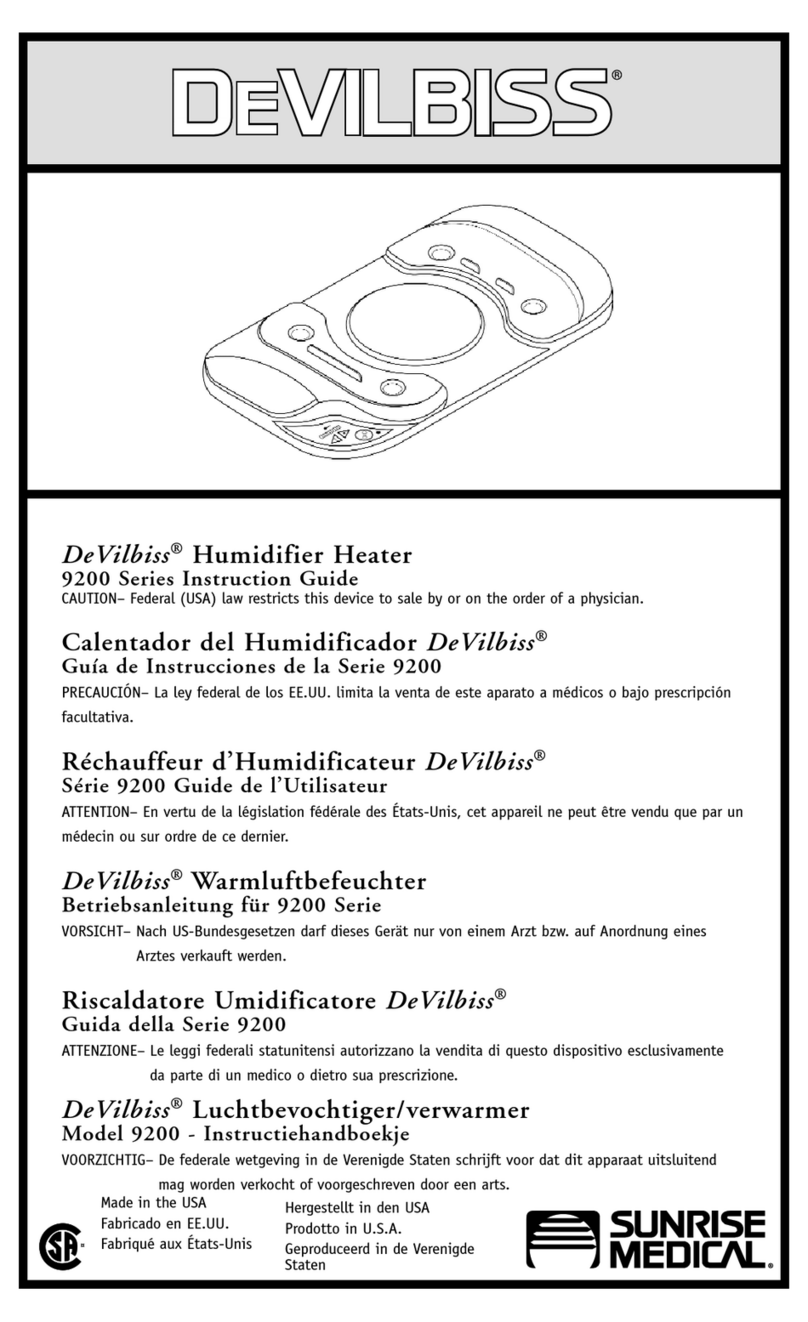
Sunrise Medical
Sunrise Medical DeVilbiss 9200 Series Instruction guide
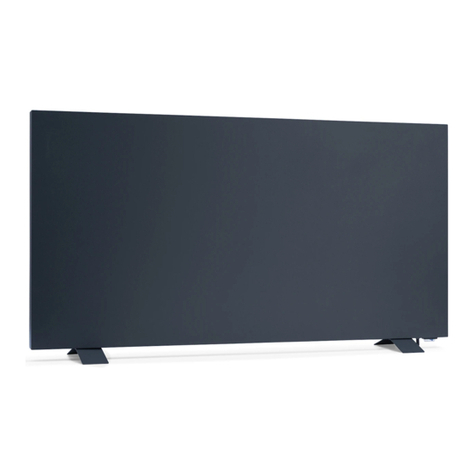
Klarstein
Klarstein Taal Smart manual
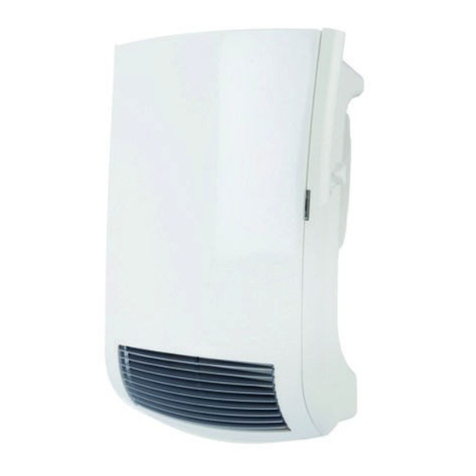
Hyco
Hyco MS180 instruction manual

Pinnacle International
Pinnacle International Remington HH-18-PCH user manual
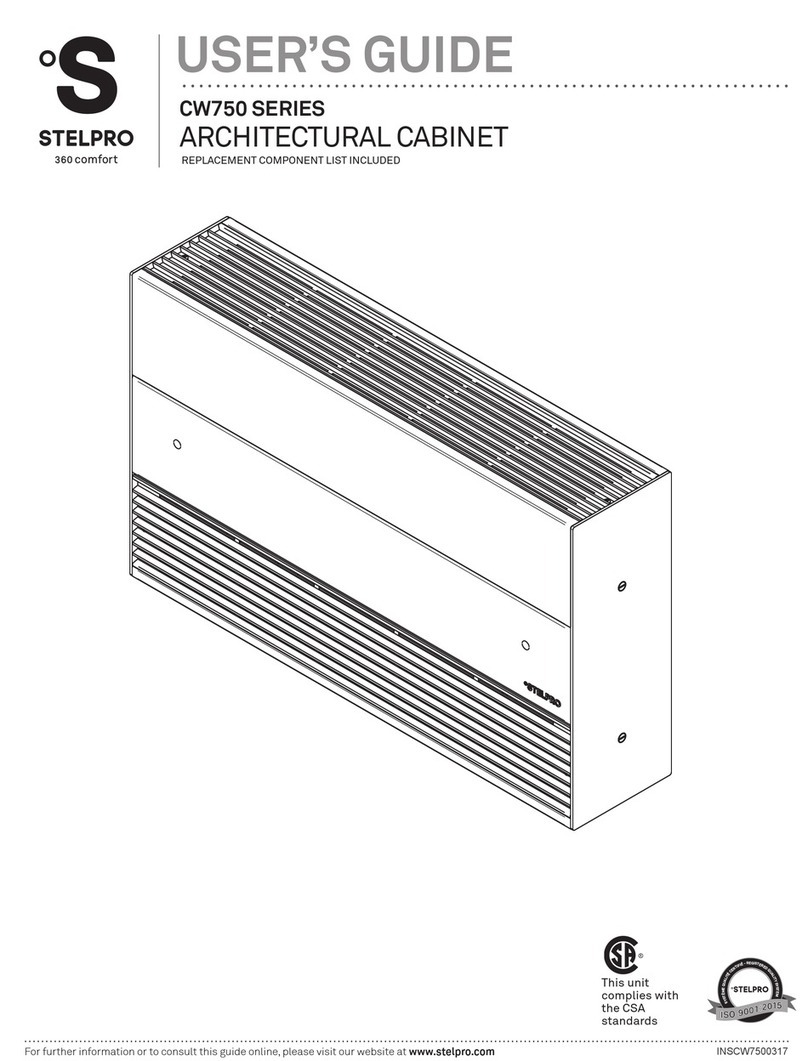
Stelpro
Stelpro CW75015372 user guide
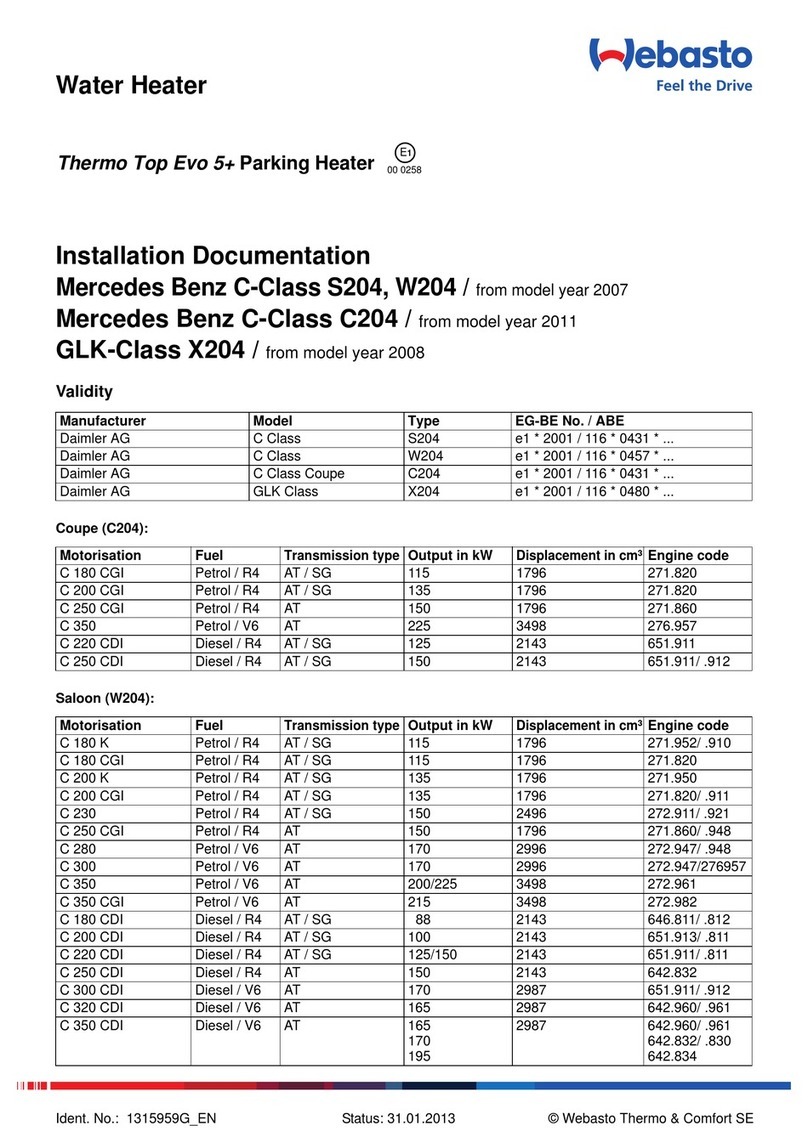
Webasto
Webasto Thermo Top Evo 5+ Installation documentation
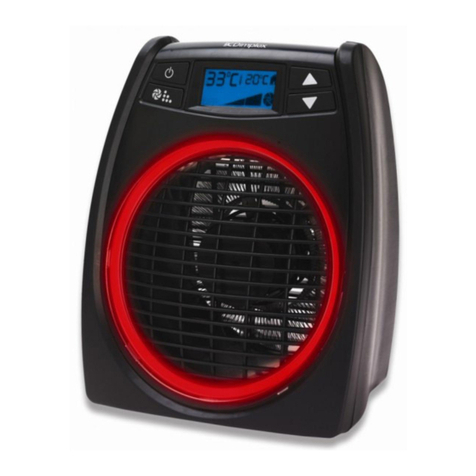
EWT
EWT PF320LCD manual
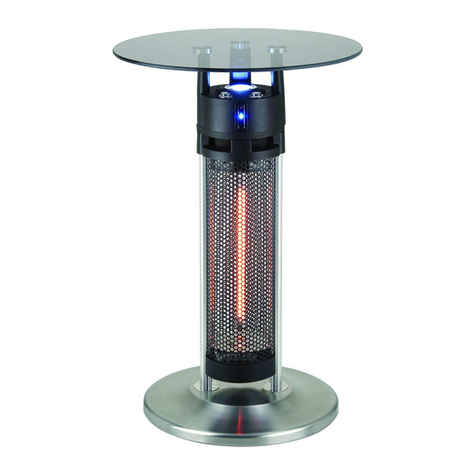
Traedgard Design
Traedgard Design Rantum instructions
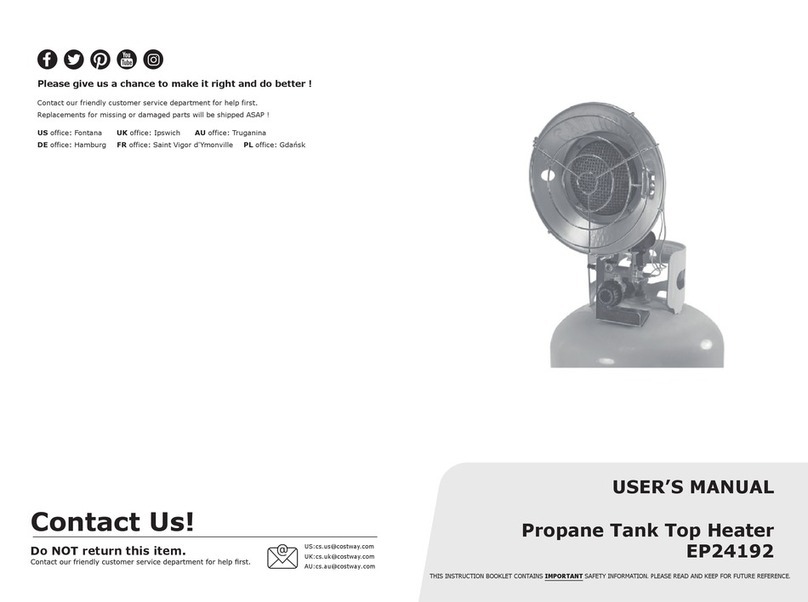
Costway
Costway EP24192 user manual
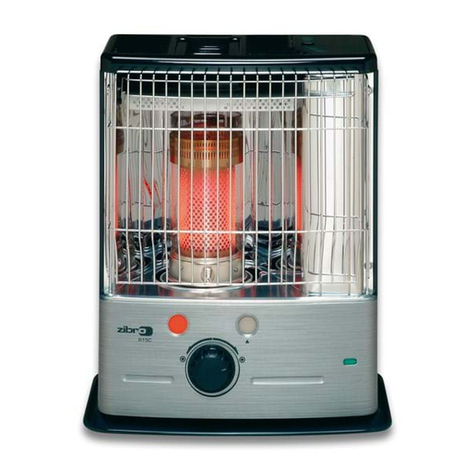
Zibro
Zibro R 15 C operating manual

Detroit Radiant Products
Detroit Radiant Products DX2 Series Installation, operation, maintenance and parts manual

Black & Decker
Black & Decker BXSH37006GB manual
